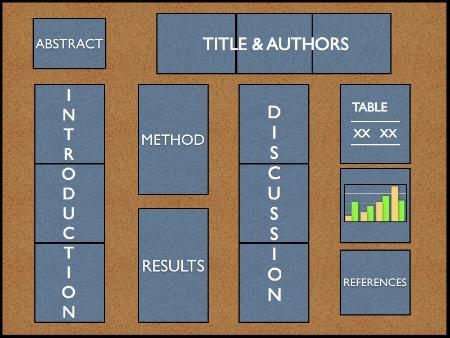Creating a Psychology Research Poster
There are two primary purposes for a poster session. 1) A person can quickly see a large number of research findings; and, 2) a person has immediate access to the authors of the research and can ask questions. Information about a typical, empirical poster is described below. In addition to your actual poster, you should also prepare the following:
- A short (e.g., 60 second) verbal "blurb"
- The purpose of this blurb is to quickly explain what you did and what you found.
- This quick summary should be geared toward an audience who wants the "bottom line" on your research, and wants it expressed in an interesting, non-technical way.
Your Poster
For professional conferences, have your poster printed on a large a single sheet of paper. At Muhlenberg, you can do that for about $35 and three days of lead time; talk to Mrs. Gonzalez for details. For Psychology Day, you also have the option of printing your poster on multiple sheets of regular paper, with each sheet backed by a professionally attractive piece of colored paper.
In most instances, you will be provided with bulletin boards and allowed to pin your papers directly to the board. Read the instructions for the poster session you are attending very carefully, however, as occasionally conference organizers want you to mount your work on a foam board/poster board. For Psychology Day, bulletin boards will be provided to you.
There are several good examples of how to construct your posters in the basement of Moyer Hall. In general, note the following:
- You need an abstract, introduction, method, results, discussion, references, and (if relevant) figures or tables
- Arrange your work such that the sections flow from top to bottom in columns, not from left to right in rows. For example:

- Use large font that can be read from a distance (i.e., at least 20 point). Your references can be in smaller font.
- You can use bullet points to organize your ideas, but write in complete sentences and/or consider how you can present your ideas visually with figures, graphs, or other images.
- Unlike a PowerPoint presentation used during an oral presentation, someone viewing your poster should be able to understand the project without necessarily talking to you.
- Note that you will probably have to pick and choose the most central aspects of your project to report given the relatively small amount of space allowed (see the posters in the basement of Moyer Hall for examples). For example, you might want to choose the one most relevant or glaring "limitation/qualification" to write about rather than listing every limitation you can think of.
- Use perfect APA style. Triple check and proof-read.
- You do need to cite your sources in the text of the poster. Note that you can automatically use "et al." anytime there are three or more authors.
- Research which is analyzed incorrectly reflects extremely poorly on the researchers (and, if your work is being graded, will generally receive a very low grade). Avoid this pitfall easily by reviewing your results with your professor prior to making your poster.
What to wear & What to do.
- You should wear business casual attire. No need to dress up excessively, but you do want to look competent and professional.
- There will probably be a name tag for you, so look for that when you arrive. In addition, you will either be assigned one of the available bulletin boards or you will be able to just choose a board to pin your poster to.
- One member of your research team should be at the poster at all times. You can take turns viewing other posters and/or listening to talks.
- When someone approaches your poster, immediately attend to that person. Smile, and offer to answer any questions. If they ask you to summarize what you did - give your verbal "blurb." Be thoughtful and responsive to questions. If you don't know an answer, no problem - say "I'm not sure; what do you think?" If you don't understand a question, say "I'm not sure I understand, could you rephrase that." Be enthusiastic about any insights the person has.
Don't forget.
- Have fun! You are the "expert" on your research topic because you have done more research on it than anyone else in the room. Take advantage of this opportunity to talk about what you found interesting about the topic, and get involved with conversations with other researchers on their topics.
Click here for advice on Paper Presentations (i.e., giving a talk)
